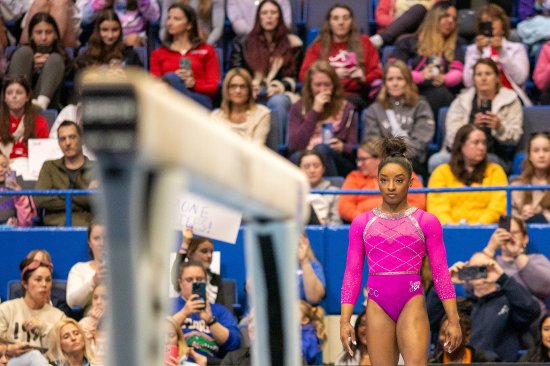
The most decorated gymnast in history keeps raising the stakes
There are two main features of any athlete earning the Greatest of All Time title—longevity and ability. Think Michael Jordan’s six NBA championships over 15 seasons, Tom Brady’s seven Super Bowl rings stretched across 23 seasons, and Michael Phelps’ 23 gold medals over five Olympics. Then there is Simone Biles, who not only easily earned a spot on her third Olympic team as the most decorated gymnast in history—with 30 world-championship medals, nine national all-around champion titles, and seven Olympic medals–but is also changing the sport itself.
[time-brightcove not-tgx=”true”]Though Biles could at this point just continue competing with the skills she’s perfected over her storied career, she keeps raising the stakes. She’s had five gymnastics moves named after her because she was the first to perform them in international competitions. Her latest, also known as the Yurchenko double pike vault, had never been attempted in competition before by any female gymnast, and only by a few male gymnasts, when she first executed it in 2021. U.S. national-team member Paul Juda, one of the handful who competes with that skill, says “her ability to pop off the table—which is 5 to 10 cm lower than the one men use—and the fact that she is a couple inches shorter than me, and she is still able to go higher than I do, takes an immense, almost ungodly amount of power.” Although she technically didn’t need to, Biles performed the challenging vault on both competition days at the recent Olympic trials in order to gain more experience with the skill under competition conditions, her coach, Laurent Landi, told TIME. “It can only get better at meets,” he said.
Read More: Meet the U.S. Gymnasts Team for the Paris Olympics
Biles’ influence on the sport goes far beyond the technical evolution she is leading. Since her early days competing at the national and international level, her gregarious personality and nurturing instincts helped catalyze a much-needed culture change in the elite program in the U.S. When Biles entered those ranks, Martha Karolyi, then the national-team coordinator, discouraged lighthearted interactions, let alone smiles, at competitions, and instead urged the athletes to remain focused and serious. Biles was different, however, and couldn’t help laughing and joking between events—it was who she was, and she and her personal coach at the time didn’t think she needed to change. “I think she’s allowed everyone around her to have a little more fun, smile more, and enjoy gymnastics,” says Jordyn Wieber, 2012 Olympic gold medalist and now the women’s gymnastics coach at University of Arkansas.
- Which Olympic Sport Is Hardest on the Body?
- What Are Olympic and Paralympic Medals Made Of?
- Why Are the Olympics Held Every Four Years?
- What Are the Origins of the Modern Olympics?
- Get Our Olympics Newsletter in Your Inbox
Biles’ accomplishments are all the more impressive given that they’ve occurred under the pall of one of the biggest sexual-abuse scandals in sports. The Paris Olympics will be the first after USA Gymnastics weathered lawsuits and an effort to decertify the organization as the sport’s national governing body following the sentencing of national-team doctor Larry Nassar for child pornography and sexual-abuse crimes. Biles was among several hundred gymnasts abused by Nassar, and her testimony, and comments about the culture that discouraged gymnasts from speaking out, in part triggered a shift to a more democratized system for team selections, one that is less reliant on the subjective opinions of a few. She also became a role model for mental-health awareness after she suddenly developed the “twisties,” in which she lost her sense of orientation in the air, and withdrew from most of her events at the Tokyo Olympics. “I felt no, the mental is not there,” she said at the time. “I need to let the girls do it and focus on myself.”
Read More: Fred Richard Is Team USA’s Next Olympic Hope for Men’s Gymnastics
It’s that ability to see the bigger picture that will also be Biles’ legacy. “She was open and vulnerable in talking about putting her mental health and safety first,” says Nastia Liukin, 2008 all-around Olympic gold medalist. “I’m inspired by the strength and humility she was able to show when faced with the immense amount of pressure she felt that I don’t think anybody fully understood.”
Biles has said that she instantly fell in love with gymnastics and continues to compete because it’s still fun, and because of everything the sport has given her. But it’s clear that this GOAT is already gifting the sport with so much more, and she’s not done yet.